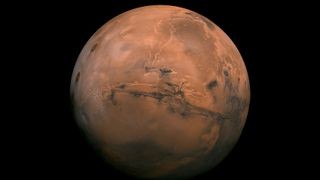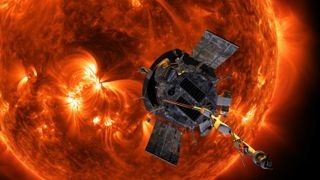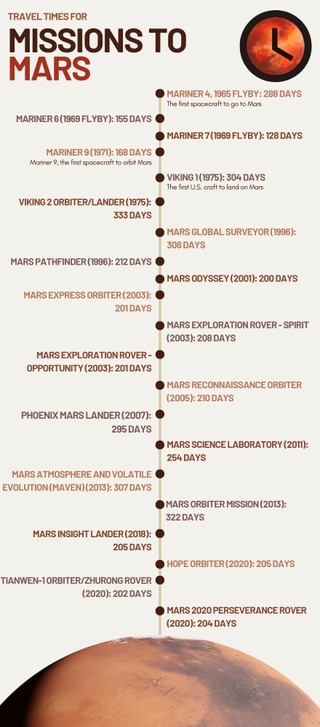Have you ever gazed up at the night sky and wondered about the incredible journey to Mars? The Red Planet has captivated our imaginations for centuries, and with advancements in space travel, the dream of sending humans to Mars is becoming increasingly real. But just How Long Would It Take To Travel To Mars?
While a common estimate suggests a one-way trip to Mars would take around nine months, and a return journey could span approximately three years, the actual duration is far more complex. Numerous factors come into play, influencing the time it takes to reach our celestial neighbor. The ever-changing distance between Earth and Mars as they orbit the sun, coupled with the type of spacecraft and propulsion technology used, significantly impacts the travel time.
In this comprehensive guide, we’ll delve into the fascinating mechanics of traveling to Mars using current and future technologies. We’ll explore the variables that dictate the length of this interplanetary voyage, providing a detailed understanding of what it takes to journey to the Red Planet.
Understanding the Distance to Mars
To accurately estimate the travel time to Mars, we first need to grasp the dynamic distance between our two planets.
Mars is the fourth planet from the sun and Earth’s next-door neighbor in the solar system – only Venus is closer. However, the distance between Earth and Mars is not constant. It fluctuates dramatically as both planets follow their elliptical paths around the sun.
At their closest point, when Mars is at its perihelion (closest point to the sun) and Earth is at its aphelion (farthest point from the sun), they could theoretically be as close as 33.9 million miles (54.6 million kilometers) apart. While this precise alignment has never been recorded in history, the closest recorded approach occurred in 2003, with a distance of 34.8 million miles (56 million km).
Conversely, when Earth and Mars are at their farthest points from the sun and positioned on opposite sides of it, the distance can stretch to a staggering 250 million miles (401 million km).
On average, the distance between Earth and Mars is approximately 140 million miles (225 million km). This vast range underscores why pinpointing an exact travel time to Mars is not straightforward and depends heavily on the planetary alignment at the time of launch and arrival.
Related reading: What is the temperature on Mars?
Traveling at Light Speed to Mars: A Hypothetical Scenario
 Image of Mars against the black backdrop of space. The planet is a rusty red color.
Image of Mars against the black backdrop of space. The planet is a rusty red color.
Light travels at an astonishing speed of about 186,282 miles per second (299,792 km per second). If we could hypothetically travel at this speed, how long would it take to reach Mars? Let’s calculate based on the varying distances:
- Closest Possible Approach: At 33.9 million miles, it would take light approximately 182 seconds, or just over 3 minutes (3.03 minutes).
- Closest Recorded Approach (2003): At 34.8 million miles, light would take about 187 seconds, or roughly 3.11 minutes.
- Farthest Approach: At 250 million miles, light would need 1,342 seconds, or approximately 22.4 minutes.
- Average Distance: At 140 million miles, light would take around 751 seconds, or a little over 12.5 minutes.
These light-speed calculations highlight the immense distances involved in space travel, even to our nearest planetary neighbor. However, current spacecraft technology is far from achieving light speed.
The Speed of Current Spacecraft: How Long to Mars with Existing Tech?
The fastest spacecraft to date is NASA’s Parker Solar Probe. Designed to study the sun, it continuously breaks its own speed records as it whips around our star. On December 24, 2024, the Parker Solar Probe achieved a mind-boggling top speed of 430,000 miles per hour (692,000 km per hour).
 Graphic illustration shows the Parker Solar Probe in front of the blazing sun.
Graphic illustration shows the Parker Solar Probe in front of the blazing sun.
Imagine if we could redirect the Parker Solar Probe from its solar mission and send it on a direct trajectory to Mars at its peak speed. Here’s the estimated travel time:
- Closest Possible Approach: Reaching Mars would take approximately 78.84 hours, or about 3.3 days.
- Closest Recorded Approach: Travel time would be around 80.93 hours, or roughly 3.4 days.
- Farthest Approach: It would take about 581.4 hours, or 24.2 days to reach Mars.
- Average Distance: The journey would last approximately 325.58 hours, or about 13.6 days.
While these travel times are significantly longer than light speed, they are still remarkably fast compared to current mission durations. However, it’s crucial to remember that the Parker Solar Probe is not designed for planetary landings or carrying humans. Missions to Mars require different trajectories and technologies, which impact travel time.
Expert Insights on Mars Travel Time: Q&A with ESA Mission Analyst Michael Khan
To gain deeper insights into the complexities of Mars travel time, we consulted Michael Khan, a Senior Mission Analyst at the European Space Agency (ESA). His expertise lies in orbital mechanics for interplanetary missions, including journeys to Mars.
Michael Khan
Michael Khan is a seasoned Senior Mission Analyst at the European Space Agency (ESA). His work focuses on the intricate orbital mechanics required for space travel to various celestial bodies, with a particular emphasis on Mars missions.
Q: How long does it actually take to get to Mars, and what are the main factors influencing the travel time?
Michael Khan: The duration of a journey between celestial bodies is primarily determined by the amount of energy we are willing to expend. In spaceflight, “energy” encompasses the power of the launch vehicle and the maneuvers executed by the spacecraft’s rocket motors, directly related to the propellant used. Space travel is essentially about the efficient management of energy.
For lunar missions, common transfer methods include the Hohmann transfer and the Free Return Transfer. The Hohmann transfer is often considered the most energy-efficient, particularly for shorter duration trips with specific launch constraints. However, Mars missions, being interplanetary, operate on orbits around the sun. The energy expenditure remains the key factor.
Adding complexity are Mars’ eccentric orbit and its orbital plane’s inclination relative to Earth’s. Furthermore, Mars takes longer to orbit the sun than Earth. These factors are visualized in “pork chop plots,” which are essential tools for trajectory experts. These plots indicate optimal departure and arrival dates and the corresponding energy requirements.
Pork chop plots reveal that launch opportunities for Mars missions occur approximately every 25 to 26 months. These opportunities are categorized into faster transfers, taking roughly 5-8 months, and slower, more energy-efficient transfers, lasting about 7-11 months. While longer durations are possible, the typical Mars transfer time is often approximated to the human gestation period, around 9 months. However, this is just a rough estimate, and precise calculations are necessary for specific launch dates.
Q: Why do spacecraft intended to orbit or land on Mars take longer to arrive compared to flyby missions?
Michael Khan: When a mission aims to orbit or land on Mars, significant constraints are added to the mission design. Orbiters require substantial propellant for orbit insertion maneuvers, while landers necessitate robust heat shields to withstand atmospheric entry. These constraints limit the acceptable arrival velocity at Mars.
Incorporating these limitations into trajectory optimization typically leads to Hohmann-like transfer trajectories. These trajectories, while energy-efficient, generally result in longer transfer durations compared to faster, direct trajectories used for flyby missions.
Challenges in Calculating Mars Travel Times: Beyond Straight-Line Distances
The simplified calculations based on straight-line distances between Earth and Mars present an incomplete picture. Spacecraft don’t travel in straight lines; they follow curved trajectories influenced by gravitational forces within the solar system, primarily orbiting the sun.
Traveling the “farthest approach” distance in a straight line would imply a trajectory directly through the sun, which is impossible. Spacecraft must navigate orbital paths around the sun.
Even for closer approaches, assuming a constant distance throughout the journey is inaccurate. Earth and Mars are constantly moving at varying speeds in their orbits. Mission engineers must calculate trajectories based on where Mars will be upon spacecraft arrival, not its position at launch. It’s akin to aiming a dart at a moving target from a moving vehicle.
Furthermore, missions intended to orbit or land on Mars cannot travel at maximum speed. Spacecraft must decelerate upon arrival to perform orbit insertion or landing procedures. Arriving too fast would make these maneuvers impossible.
Technological advancements in propulsion systems also play a crucial role in determining Mars travel time.
NASA’s Goddard Space Flight Center indicates that an ideal launch window for Mars, considering planetary alignment and efficient trajectory, results in a journey time of approximately nine months. Physics professor Craig C. Patten from the University of California, San Diego, explains this further:
“The elliptical orbit which carries you from Earth to Mars is longer than Earth’s orbit but shorter than Mars’ orbit. Averaging the orbital periods, it takes about one and a half years to complete this transfer orbit. However, due to planetary motion, launch windows occur roughly every 26 months.”
Shortening the travel time is possible by using more powerful propulsion and burning more fuel, but current technology often prioritizes fuel efficiency for deep space missions.
Future Propulsion Technologies: Reducing Mars Travel Time
Evolving technologies hold the promise of significantly reducing Mars travel times in the future.
NASA’s Space Launch System (SLS), currently under development, is designed to be a powerful workhorse for future deep space missions, potentially including crewed Mars missions. The SLS aims to provide greater thrust and payload capacity, which could contribute to faster transit times.
Looking further ahead, revolutionary propulsion concepts like photon propulsion could drastically reduce interplanetary travel time. Photon propulsion, or directed energy propulsion, utilizes powerful lasers to accelerate spacecraft to velocities approaching the speed of light. Professor Philip Lubin and his team are developing Directed Energy Propulsion for Interstellar Exploration (DEEP-IN). Lubin suggests this technology could potentially send a robotic spacecraft to Mars in as little as three days.
“There are recent advances which take this from science fiction to science reality,” Lubin stated at the 2015 NASA Innovative Advanced Concepts (NIAC) symposium. “There’s no known reason why we cannot do this.”
While photon propulsion is still in the research and development phase, it represents a potentially game-changing approach to drastically shortening Mars travel times in the future.
Historical Mars Mission Durations
 Timeline of missions to Mars.
Timeline of missions to Mars.
Examining past Mars missions provides a real-world perspective on travel times. The infographic above and the list below detail the duration of several historical missions to Mars, including both orbiters and landers:
- Mariner 4: Launched November 28, 1964, reached Mars flyby on July 15, 1965 (approx. 7.5 months travel time).
- Viking 1 Orbiter: Launched August 20, 1975, entered Mars orbit on June 19, 1976 (approx. 10 months travel time).
- Mars Pathfinder: Launched December 4, 1996, landed on Mars on July 4, 1997 (approx. 7 months travel time).
- Mars Exploration Rovers (Spirit & Opportunity): Launched June 10 & July 7, 2003, landed on Mars January 4 & 25, 2004 (approx. 7 months travel time).
- Mars Science Laboratory (Curiosity Rover): Launched November 26, 2011, landed on Mars August 6, 2012 (approx. 8.5 months travel time).
- Mars 2020 Perseverance Rover: Launched July 30, 2020, landed on Mars February 18, 2021 (approx. 6.5 months travel time).
These historical missions demonstrate that travel times to Mars typically range from around 6.5 to 10 months, aligning with the general estimates and expert insights discussed earlier. Variations in travel time depend on specific mission trajectories, launch windows, and mission objectives.
Conclusion: The Journey to Mars – A Balance of Time and Technology
So, how long would it take to travel to Mars? Currently, with conventional propulsion systems, a one-way journey to Mars typically takes around 6 to 9 months. However, the precise duration is a complex interplay of factors, including the ever-changing distance between Earth and Mars, the chosen trajectory, and the technological capabilities of the spacecraft.
Future advancements in propulsion technologies, such as the Space Launch System and potentially revolutionary concepts like photon propulsion, hold the promise of significantly reducing Mars travel times. While a three-day trip to Mars might still seem like science fiction, ongoing research and development are pushing the boundaries of what’s possible in interplanetary travel.
The journey to Mars is not just about speed; it’s about carefully managing energy, optimizing trajectories, and developing innovative technologies to make this ambitious endeavor both feasible and efficient. As we continue to explore the Red Planet, the quest to shorten travel times remains a critical aspect of making Mars exploration more accessible and sustainable for future generations.
Further Resources:
- Explore NASA’s long-term vision for lunar and Mars exploration: Moon to Mars overview.
- Learn more about the complexities of sending humans to Mars and returning them safely: How to get people from Earth to Mars and safely back again.
- Understand the human health challenges associated with Mars missions: Research paper on human health risks of Mars missions
Join the Conversation:
Join our Space Forums to discuss the latest space missions, night sky events, and more! Share your thoughts and questions about traveling to Mars.
Stay Updated:
Get the Space.com Newsletter – Receive breaking space news, rocket launch updates, skywatching events, and the latest insights into space exploration directly in your inbox.
About the Author:
Daisy Dobrijevic, Reference Editor
Daisy Dobrijevic is a seasoned science journalist and Reference Editor for Space.com. With a PhD in plant physiology and a Master’s in Environmental Science, Daisy brings a strong scientific background to her space reporting. Prior to joining Space.com, she contributed to All About Space magazine and the BBC Sky at Night Magazine. Daisy is passionate about making space science accessible to the public and has a keen interest in solar activity, space weather, and astrotourism.
With contributions from Space.com staff.